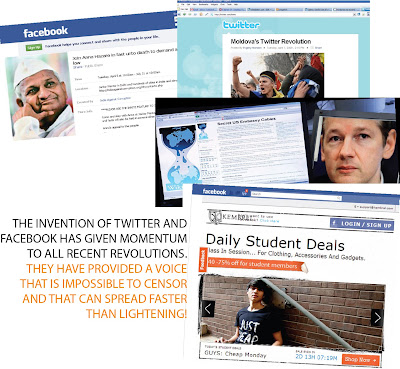Surprises in-store
In-store marketing is increasingly turning into a virtual last mile for marketers, which could play a major role in their long term success
Walk into Wal-Mart and chances are you will come across a TV showing how Listerine Agent Cool Blue pre-brushing rinse turns plaque blue. This is not a regular commercial that you would see on TV. Rather it’s an “infomercial” that is custom-made for retail stores and chances are after seeing it you might just pick up a bottle of Listerine – just to give it a shot.
Reebok stores around the country recently carried out a fitness test for people who walked into their stores. The customers were asked some questions and based on that the retail attendants mapped their fitness levels and even gave the customers suggestions to improve their level of fitness.
This Diwali, Planet M placed kiosks in its music stores from where customers could download songs.
A 34-feet long Heritage Wall greets you in Bangalore. Its touch-sensor links make it a virtual scrapbook that depicts decades of history of Levis. Marketing has a new baby and it’s being touted as the hottest new medium. You may see it dangling from the ceiling or pasted on the floor or being flashed on TV screens inside shops or maybe even on the trolley carts. Its importance is in fact growing almost at the same pace as that of the internet. It’s called “mall marketing” or “shopper marketing.” “In-store marketing” is the latest way in which marketers are trying to reach the wallets of consumers.
Why in-store marketing?
The world’s largest advertiser Procter & Gamble has cut down part of its ad-spend on TV and increased its spending on in-store marketing/advertising. P&G spends at least $500 million annually on shopper marketing today.
Krrish movie merchandise was sold exclusively through Pantaloon stores with the assistance of in-store advertising.
Today, thanks to retail chains and retail becoming more and more organised, the complete endeavour of shopping is changing. Most of our purchases today are unplanned and impulsive. Shopping is no more a chore but an experience and retailers are going all out to make it as pleasurable for the shoppers and as profitable for them! This is the “last mile”. It’s the last chance marketers have to make a sale and it’s proving to be the most fruitful “last mile”. After all, a shopper inside a retail store is most prone to buy. Research, too, has proved that more than 70% of purchase decisions are made inside the store. So chances of an advertisement being seen in-store and causing a sale is more than an ad seen “in-home” or elsewhere. Not surprising, then, that “In-Store-TV” is becoming so popular now-a-days, where content is made specifically to suit the needs of the retail-chains and the customers. Wal-Mart TV today is probably more influential than regular TV. According to a T. N. S. survey done in 2005, after seeing ads on Wal-Mart TV (inside Wal-Mart stores), 15% people purchased the product the same day, proving that Wal-Mart TV drives significantly higher motivation levels than advertising for similar brands on in-home TV.
Traditional media like TV and press have got too cluttered and customers have learnt how to avoid the ads here. In-store advertising seems to work wonders for marketers.
It’s a whole new world in-store for you
Gone are the days when cardboard danglers were the most novel way to promote your products in-store. Retail store design is a whole new medium. Intelligent retail store designs are actually improving sales. Titan discovered that after trying seven or eight watches, the customers were a little hesitant to ask the salesboy for the 9th one. So they designed a card reader which was given to every customer who entered the store. He could record the codes of these watches and once he was done, he would be presented his collection on a tray – to see, try out and select at leisure without any salesperson being involved!
In-Store-TVs are the latest entrants and have contributed to a 20% lift in sales. Not just do they show ads specifically designed for the retail outlet, but also entertain shoppers. Hypercity has introduced digital signage in its consumer electronics section to help customers understand the various features of products. In its kitchen section, chefs demonstrate the use of the latest kitchen appliance and customers can even taste the dish – before deciding to buy the appliance which helped cook it.
Shopping is being made more enjoyable. H&M, the Swedish clothing giant, has put flat screens behind the cash registers where people waiting to pay (often in very long queues) at the cash counter are kept entertained. Macy’s has flat screens, which show the football games each Saturday. While the wives shop, the husbands watch football.
With 74% of buying decisions and 37% of brand switching decisions happening in-store, “In-Store-TV” has become a very powerful marketing tool today. Think of it… with more then 50 brands of toothpaste, 175 types of teabags, 285 types of cookies, 360 types of shampoos to choose from, which one will you pick? Probably the one whose ad you saw a few seconds back on the In-Store-TV, which not only entertained but informed too. Almost every retail chain is coming out with its TV. Future TV from Kishore Biyani group is going the Wal-Mart TV way in India. League One is another big player in this area.
Decades ago, what started as signs on shopping carts has today grown to unrecognisable promotions. In-Store-Marketing is reaching new heights. The “Mall” is the medium for advertisers. Marketers are queuing up in front of them for this is their chance, rather their last (but not the least!) chance of getting to interact with customers.
Retailers all the way
Retailers have never had it so good. Everyone from banks to credit cards, to airlines, wants to be seen inside these retail outlets. They all want to connect with the consumers for inside a shop, the consumer is in a buying “frame of mind”. It is the sheer mobility that retail marketing affords. Some 40,000 customers walk in on a weekend at a Big Bazaar outlet. So Big FM doesn’t hesitate to pay Rs.1 lakh per month for each Big Bazaar store to play its radio station.
Hutch and Worldspace prefer to be seen inside a Barista Café. Nerolac has now decided to promote its paints with Disney characters inside KFC outlets.
In China, in-store advertising contributes 4-6% of the total sales of a store. Mumbai malls estimate that selling ad space in-stores accounts for 15% of the mall’s revenue. It has becoming an important stream of revenue for retailers. So much so that Shopper’s Stop has now recruited a team to look after their in-store marketing initiatives.
With prime time TV prices increasing & viewership dropping, with increase in clutter, marketers have realised that brands can best be built in a retail environment. In-store-TV today is more effective than In-Home-TV. With innumerable brands and endless varieties, marketers have realised how important it is to be visible to the consumer just at that moment when he is about to decide what to buy.
Shops are being re-dressed and revamped, consumers are being pampered to the fullest inside these shops and marketers are working hard to showcase their brand – one last time – in such a manner that it seems irresistible to the consumer. After all, in-store displays are found to add significant incremental volumes, over even price cut activities by companies. For consumers & marketers alike, retail outlets are turning out to have a whole lot of surprises in-store.


Comments
Post a Comment